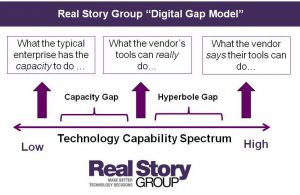Software Isn’t the Problem
Everyone wants to believe their shortcomings lie elsewhere. Humans are really good at placing the blame on anything but themselves.
Often, this surfaces as limitations that we’ve convinced ourselves exist and are holding us back.
If only I didn’t have to do my chores, I could be a better guitar player.
If only the gym was closer, I would workout more.
If only traffic wasn’t so bad in the morning, I wouldn’t be late for work.
If only…
The Projection Defense
This is called projection.
Psychological projection is a defense mechanism in which the human ego defends itself against unconscious impulses or qualities (both positive and negative) by denying their existence in themselves while attributing them to others
No, no, you’re right – it’s not you. It’s clearly everyone else that’s wrong.
We take limitations or shortcomings that are inherent to us, and we project them onto some other thing. That thing is the problem, not us.

We do this with software all the time. We blame software limitations for what ails our organizations. If only we had better software, things would be different. There’s no point trying to be better, because we’re hobbled by poor software.
Some of this might be true, certainly. But a non-trivial portion of it isn’t. We put too much emphasis on software’s abilities to make up for our shortcomings.
We look at new software like a kid with their nose pressed up against the window of a candy store. If only we had that software package, then everything would be different.
But…would it? If you had the latest software package for whatever industry or practice you’re managing, would everything really be different? Would you expand to your full potential and begin to make leaps and bounds toward your goals?
If the gym was a little closer, would you really become the triathlete you’re sure you could be?
Probably not. We project negativity onto existing software and positivity onto software not-yet-acquired, but often the limitations are outside the software. It’s not the software holding us back.
My talk for 2017 was called Why Content Projects Fail. I gave it 6-7 times around the world, and this slide below never failed to get a laugh.
This is all of us:

In my talk, I discussed why we project our problems onto software:
- There’s a good chance significant parts of our problem originated externally to technology
- But, we tend not to look to people, governance, or process, because these things exist now
- If the problems could been fixed without new technology…then why weren’t they? We had all the control.
- It’s easy to say, “Things will be better when we have new technology because we’ll have something we don’t have now. We just don’t have the right tools now.”
Blaming software is a handy way out of awkward questions. And software has no opinion and no defense – your old software can’t shirk this blame, and your new software can’t realistically manage your expectations.
I’ve written about this before in relation to several different CMS features –
Content Personalization: A Reality Check (October 2016):
The sad truth: most organizations can barely manage a single effective version of their content, much less multiple versions. No client I know has multiple versions of their content just sitting around, tailored to different audiences. This is something you see in case studies, but that few organizations actually have the resources to do.
The Truth About CMS Form Builders (January 2017):
After your website launched, how many forms did you need built in the following year? For most of my clients, the answer is “not many.” How many forms will you need built in the next year? It’s usually the same answer.
You Want Collaboration, Not Workflow (June 2014):
Seemingly every project has grand plans around workflow. Editors are going to submit content to an approver, then it’s going to an editorial committee of which 60% need to sign off, then it’s going to a metadata specialist, then the legal department, and then it will be published when the temperature in Moscow hits 60 degrees and the Oakland Raiders win the Superbowl, etc. Of course, none of this ever happens.
I sound like a cynic, but 22 years in this business has taught me that all of the above is accurate.
Truth: if the shackles were thrown off and they had all the marketing tools at their disposal…many (most?) customers just wouldn’t know what to do with them all. They’ve pinpointed their problems as deficient or missing software, but this implies that if this shortcoming was patched, everything would fall into place, and this is just not true in so many cases.
This reminds me of YAGNI, the programming principle of “You aren’t gonna need it.”
[…] a programmer should not add functionality until deemed necessary.
Perhaps we should modify it to “YAGUI: You aren’t gonna use it.”
The Boring Truth
Now, I’m not saying all marketing tools are pointless. This market is ruthless, and if they didn’t work, they’d get drummed out of existence. But they’re still around, so someone is getting value from them.
How do they do it? Magic?
Nope. Just boring stuff like –
Adequate Staffing
If you’re planning an expansion of your digital marketing technology, you need to take stock of your staffing. This stuff takes work. Is everyone sitting around with nothing to do? If not, you need to be prepared to hire.
In fact, I just read a book entirely dedicated to the idea of building a “content team,” which is an idea foreign to a lot of organizations because content just kinda…happens, or “someone from marketing handles that.”
And it’s not just you – this article is a blistering indictment of the implementation of an electronic records system at a hospital. They found that it meant they had to hire more people – each doctor now had to have a “scribe” follow them around to patient visits to “work the software” while the doctor did their original job.
Adequate Training
Software likes to pretend that it’s easy to use and everything “just works.” This is compounded in the era of AI and ML (“It learns by itself!!”). Don’t believe it. You’ll likely need formal training to activate the software and evaluate the results.
Consider: Sitecore is so complex that it has an entire service line – Sitecore Business Optimization Strategies – that uses your Sitecore installation for you. You can buy a car and a driver in the same transaction.
Adequate Time
Transformation doesn’t happen overnight. You’re going to make a lot of mistakes. Once you have all the tools at your disposal that you were convinced you need, give yourself a year to make All the Mistakes™.
You need time to absorb all that new functionality, figure out how to work it into your processes, probably shed or swap some people, and then actually get down to business. Search for the phrase “software adoption” sometime. There have been many, many books written on the psychology and time required to get people to adopt new processes. This is not just like flipping a switch.
(Michael Sampson has written a good book here – User Adoption Strategies. It’s a bit Sharepoint-centric, but still widely applicable.)
Adequate Leadership and Vision
If the things you want to do are as transformational as you believe, then you’re going to need to paint a picture for the rest of the organization to get on board. You’re going to have to slay political dragons and fight for budget, people, and reorganization. We might need to reframe your organization’s entire relationship to its content and communications channels.
A client was just in my office last week to discuss rebuild of their website. As we talked about different technologies we could bring to bear, it became obvious that their relationship with their customer was still rooted to when they started the company in 1986. Some of their processes were just thinly-veiled versions of the originals. They needed to completely change how they related to their customer.
New technology might lay these situations bare, and there’s no ThanosSnap 5.0™ that’s going to magically fix what you find. You might be waking a sleeping giant, and you need to make sure you have the leadership, vision, and executive backing to see it through when it unravels.
…
Software doesn’t work in a vacuum. It’s nothing but a tool that assists an otherwise healthy and prepared organization to move forward. It’s a force multiplier – it can absolutely make you better, but you have to bring something to the party.
The Awkward Part
Here’s what gets tricky as a someone in software and service sales: how do you tell someone that the software isn’t the problem?
I was at a Boye and Company CMS Experts Group meeting in Brooklyn two weeks ago, and we had a raging discussion about the Hertz Accenture fiasco that’s in the news right now. Some of us expressed amazement at the $32 million price tag. Clearly, Hertz is a big customer with big needs, and there’s a lot of integration there, but…$32 million?
We imagined someone at Accenture and Adobe just selling Hertz everything they could toss into the deal, whether Hertz could use it or not.
Of course, we debated, what’s the alternative? As people selling software and sales, do we need to pretend that customers can use everything we sell? Or should we advocate for our customers and tell them that we just don’t think they’re going to get any use out of Feature X?
A pause…then John Eckman from 10Up said what everyone was thinking:
If you do that, then you’re passing judgment on their skill level.
And he’s right. If I tell a customer they shouldn’t buy a personalization engine because they’re not going to use it, what I’m really saying is:
The problem isn’t the software. The problem is you. You just don’t have the skill to use that.
It might be graceless, but there it is.

Obviously, you can’t say that. But what you can do is nudge this customer toward a more holistic approach to their software when they have unrealistic expectations. From the prior post about personalization:
When I discussed personalization with a client once, I kept asking them, “Okay, now that we know who the visitor is, what do you want to do about it?”
They kept responding: “Well, we want to change the value proposition.”
This isn’t enough. There is no button in your CMS that says “Change the value proposition.”
My client was convinced the software would Just Work.
In reality, personalization actually made their job harder because it put them in a position where they now had to bring acute content strategy to bear to respond to an identified audience. Put another way: ignorance is bliss, and if your software can now resolve your ignorance and enlighten you to tiny changes in your audience demographic, are you skilled enough to do anything about it?
These things can’t be easily deconstructed, and the software can’t save you. Some problems are complex just because they’re complex. This stuff isn’t magic.
Customers need to be introduced to the breadth of what they need to do, then guided into a integrated approach that circles all the organizational wagons around whatever uber-feature they have their eye on.
Otherwise, you just aren’t gonna use it.
Words with Friends
I wanted to make sure I wasn’t all alone on this, so I got in touch with a few friends to get some outside perspective.
Here’s Jessica Fardin, CMO of Episerver who says the organization’s culture is often to blame.
Software only becomes a vanity fix if a company’s culture isn’t onboard to really diagnose problems from top to bottom. You can’t blame the plumber if you never opened the walls and just painted over a leak in the ceiling.
I’ve witnessed the most successful Episerver customers not being afraid to communicate operational flaws with impacted groups often and early. It’s OK to say, “This isn’t working.”
The alternative is finger pointing after the fact and, to Deane’s point, it’s less awkward to blame a platform than a person or the processes they can’t let go of.
First, never under-estimate any organization’s ability to point fingers. Second, that last point is so true, especially the word “awkward.” It’s easy to blame software because you can’t hurt its feelings, and it won’t demand severance pay. It’s easy to walk away from.
Here’s Tom Wentworth, SVP of Product Marketing for Acquia who points some of the blame back at vendors.
There’s an Innovator’s Dilemma problem in web content management. Products are evolving in capabilities and complexity at a much faster rate than customers are able to consume them.
Vendors get some of the blame because we make it look so easy to deliver a personalized 1-1 customer journey in a product demo. The truth is that customers underestimate the impact of organizational change.
You can’t just double click on “DigitalTransformation.exe”. The customers who are most successful – and avoid the $32 million dollar price tag – are the ones who do the hard but boring work to connect people, process, then products.
But vendors do need to simplify our products to help customers get to value faster. The future of web content management is less complexity, not more.
I give Tom credit for going there. Vendors reinforce “Wedding Day Syndrome” – your spouse is never gonna look better than on your wedding day. When you see them all made-up in a wedding gown or looking dapper in a tux and tails, don’t get the idea that this is how it’s always going to be. They’re just not gonna look that good stumbling back into bed in a vomit-stained t-shirt after a 3 a.m. feeding.
So far, we have customers and vendors to blame. For some balance, here’s Arild Henrichsen from Epinova who says that we integrators share some of it.
We can’t forget that there is also a middle ground between the over-promise of vendors and the skill limitations of users: Botched CMS implementations by agencies.
The most competent CMS platform and editorial team can be rendered almost useless by a bad implementation – usually from a team that either lacks understanding of that particular CMS platform, or lacks understanding of the customer’s needs.
Integrators have a special responsibility to strike that balance between customers’ creative ambitions and their skillset – creative flexibility vs editorial control – and executing implementations in a way that can scale as the customer reaches a higher level of digital maturity.
Sure, I’ll take that blame.
But, just to keep score, The Blame Game™ is currently:
- Customers: 1
- Vendors: 1
- Integrators: 1
- Software: 0
(Or Humans 3, Computers 0, depending on how you want to roll that up.)
Back to vendors for a second –
Tony Byrne from Real Story Group provides this slide which presents the “Capacity/Hyperbole Gap” problem. On the far right is what the vendor claims their software can do under the best conditions. Moving leftwards we find what the software can actually do assuming you have the skill to use it. Then far left is what the software can do with the skill an average customer actually possesses.

Tony adds:
I think an organization that really focuses on capacity building first and tools later is going to discover that they can get away with much simpler tools at the customer engagement tier and push complexity down in the stack.
Here’s Brody Dorland, co-founder of DivvyHQ, an editorial management platform, who says that organizational pain drives motivation.
The two main drivers for success in the Divvy world seem to be “shared pain” and “readiness.” And the two actually go hand in hand.
Meaning, a good number of folks walk through our virtual front door everyday and, upon our initial conversation, they have communicated some level of pain in their current processes. But pain can come from the top (i.e. leadership lacking visibility/oversight into a siloed operation), or from the bottom (i.e. users in the trenches).
More often than not, only one of these groups is hurting and driving for change. That’s an average customer for us and we may not get full adoption. But once in a blue moon, both the top and bottom have come together, acknowledged each other’s shared pain points, and recognized that they are “ready” for a change.
Those on the top need to feel the tactical pain of those on the bottom; and those on the bottom need to appreciate the organizational pressure felt by those on the top. This is basic human empathy – we need to step into each other’s shoes and try to feel what they feel.
Here’s Brandon Kelly from Craft CMS:
All the successful Craft shops have mastered the art of follow-through. Even if an implementation seems like a perfect fit on day one, it’s not going to last. Business needs and workflows evolve. If the CMS doesn’t adapt to those changes, the client will grow to resent it and eventually look for a new solution, and a new partner.
So, Brandon is pushing for a refined implementation over time. Get it in, then smooth it out on the back slope.
And here’s “Rock You Like a Carrie Hane” (that joke will never get old) from Tanzen who says you should start with the goal state and work backwards.
My clients’ and students’ technology is never perfect, so we get creative and work backwards from the ideal. We create our strategy with no tech stack in mind, but what needs to be accomplished. Then we either find tech to support the goals or figure out how we can adjust our tactics using what we’ve got.
To repeat Carrie: “no tech stack in mind.” Get your non-tech house in order first.
All these people are seasoned professionals who have forgotten more about this business than most people will ever know. And I have yet to find someone who is willing to blame the software.
To make sure I got as many angles as possible, I reached out to Meghan Walsh, Senior Director of Content Services for Hilton. Meg is well-known in the content community as a doer – someone in the trenches trying to make all this theory work.
Meg says:
I’ve worked places with dying CMS platforms and been able to do great things with content – maybe not as much as we hoped – but great things – because we focused on the what of content first - -which is all people and process and goals. It’s the system-agnostic stuff. The technology is the how.
I’ve made some bad decisions in my career about content structure, use and operations. Some of those bad decisions were hidden behind the curtain of the technology. I’m continually trying to learn from that.
[…] Technology is the easy blame because it is, well, technology. As a practitioner, as a content leader in my company, I can’t take the easy way out.
Let’s round this out with the legendary Karen McGrane, a friend with whom I’ve shared many war stories and commiserated over many drinks.
I say flat out to clients all the time “your technology isn’t your problem. YOU are your problem.” And everybody laughs, probably because they’ve all been through enough implementations to know that the software won’t save them.
They say that success has many parents, but failure is an orphan. To me it seems like this failure has all kinds of deadbeat parents. Execs that just want to write a big check and make a problem go away. Budgeting that allocates money for software but not services. Under-resourced internal teams that don’t have the influence they need to make changes. Unrealistic timelines that don’t allow for the kind of iteration we take for granted in other processes.
Never enough time and money to get it right, but always enough to do it over.
I saved Karen for last because I was sure she was gonna put the period on this sentence, and I’m not sure I can add anything more to that.
Parting Thoughts
Earlier this week, I was having a DM conversation with Mark Demeny from Sitecore about something. We realized, to our delight, that we were both going to be in Copenhagen at the end of the week. So, that Friday, I had a lovely dinner with Mark and Amanda Shiga overlooking Copenhagen’s South Harbor (in this spot).
CMS geeks are gonna geek, and we dutifully talked for a couple of hours about all the usual topics, companies, and people (our greatest accomplishment might have been to awaken CMS Borat after almost three years of silence). I love it when people who are passionate about something have free time to go deep, and this was that kind of dinner – none of us had anywhere we needed to be.
Towards the end, our conversation turned to how we can actually get better as professionals in this industry. Related to this, I’ve had discussions with multiple people over the years about the idea of an “unconference” in Reykjavík or somewhere thereabouts (we have our eye on this hotel).
Mark, Amanda, and I discussed what this might look like: who would we have speak, would we have some collective theme or goal, and what would be the value proposition? There are a lot of angles to this business, and what front should we attack first?
In the end, we centered about this idea –
The most valuable thing we could do would be to talk about organizational and personal psychology and motivations.
Far more than software, this is the biggest problem we face in this industry – getting organizations out of their own way and finding ways to get groups of people working effectively and consistently towards a common goal. The best idea we had was to invite a bunch of organizational therapists to the event and just listen.
Afterwards, I was reminded of one of the best business books I’ve ever read: The Advantage by Patrick Lencioni. (Honestly, you could swap in any number of Lencioni’s books here: The Five Dysfunctions of a Team; Silos, Politics and Turf Wars; etc.).
In The Advantage, Lencioni says this:
Most leaders prefer to look for answers where the light is better… and the light is certainly better in the measurable, objective, and data-driven world of organizational intelligence than in the messier, more unpredictable world of organizational health.
You could substitute almost anything for “organizational intelligence” in that sentence (i.e. “technology”) because almost anything else is easier than confronting the messy reality of human frailties, egos, and shortcomings. So we look elsewhere, at easier targets.
But the light isn’t any better, we just don’t like the dark.
Someday, all of us consultants, engineers, and designers are going to finally summit The Mountain of Efficacy and reach that place when we have figured out the most effective way to move our clients forward.
On that day, when we at last pull ourselves over that peak, exhausted and bleeding, we shouldn’t be at all surprised to find a bunch of governance, operations, and strategy experts who have been sitting there for years.
Postscript: Romano Tours
This SNL sketch is worth watching. It might accidentally be the deepest, most thoughtful bit they’ve done in years, and it highly relates to this post.
You are still going to be you, wherever you go, and no matter what software you use.